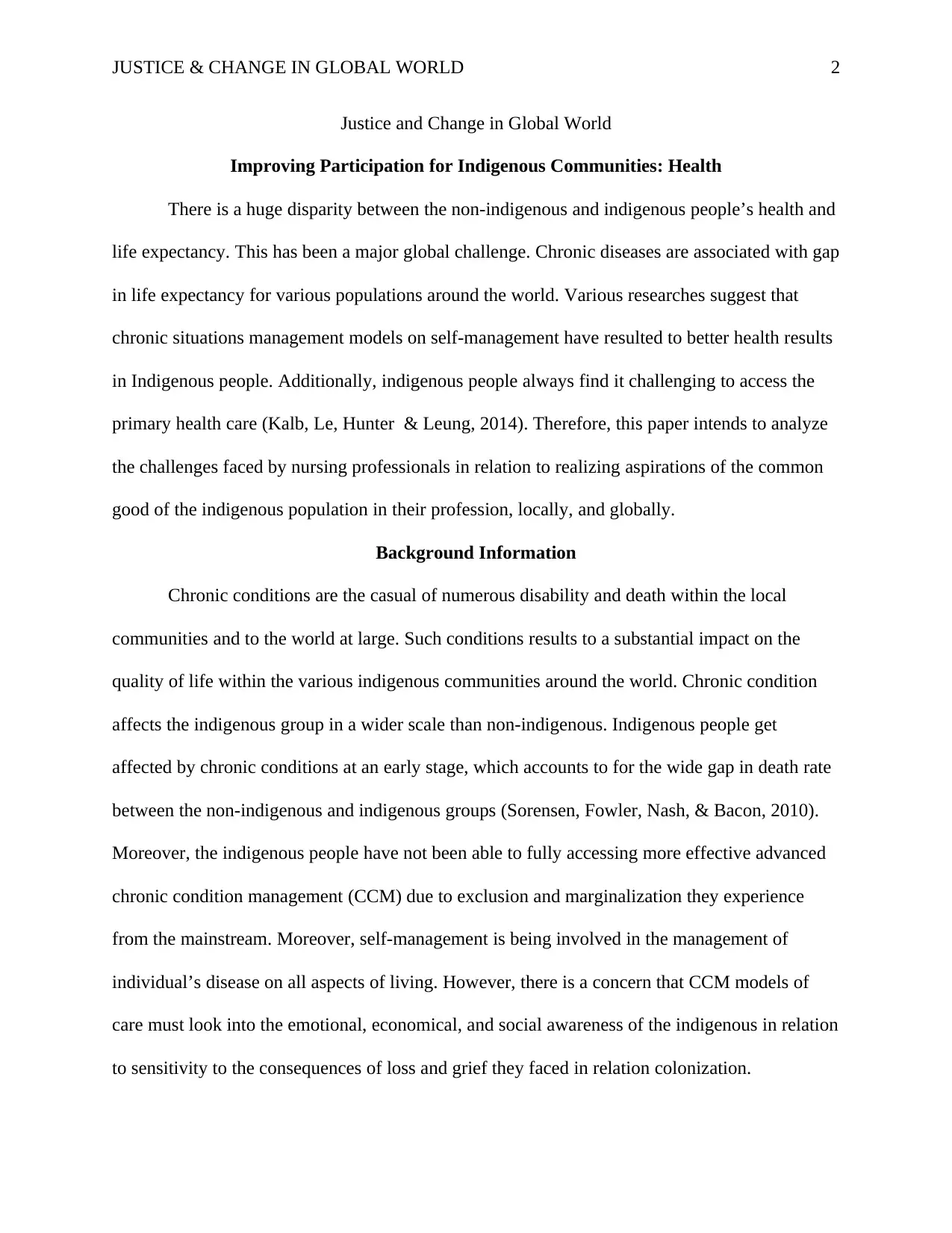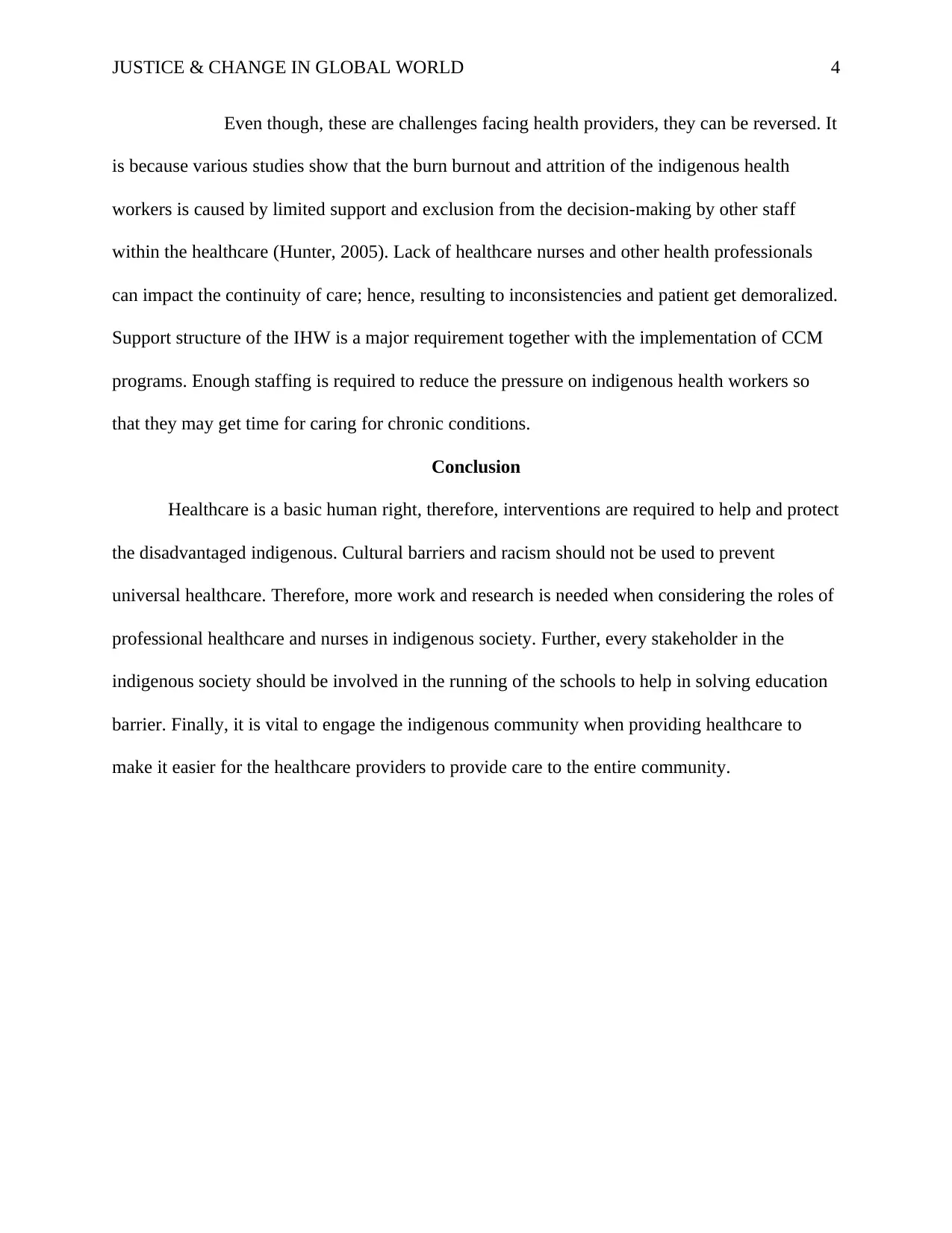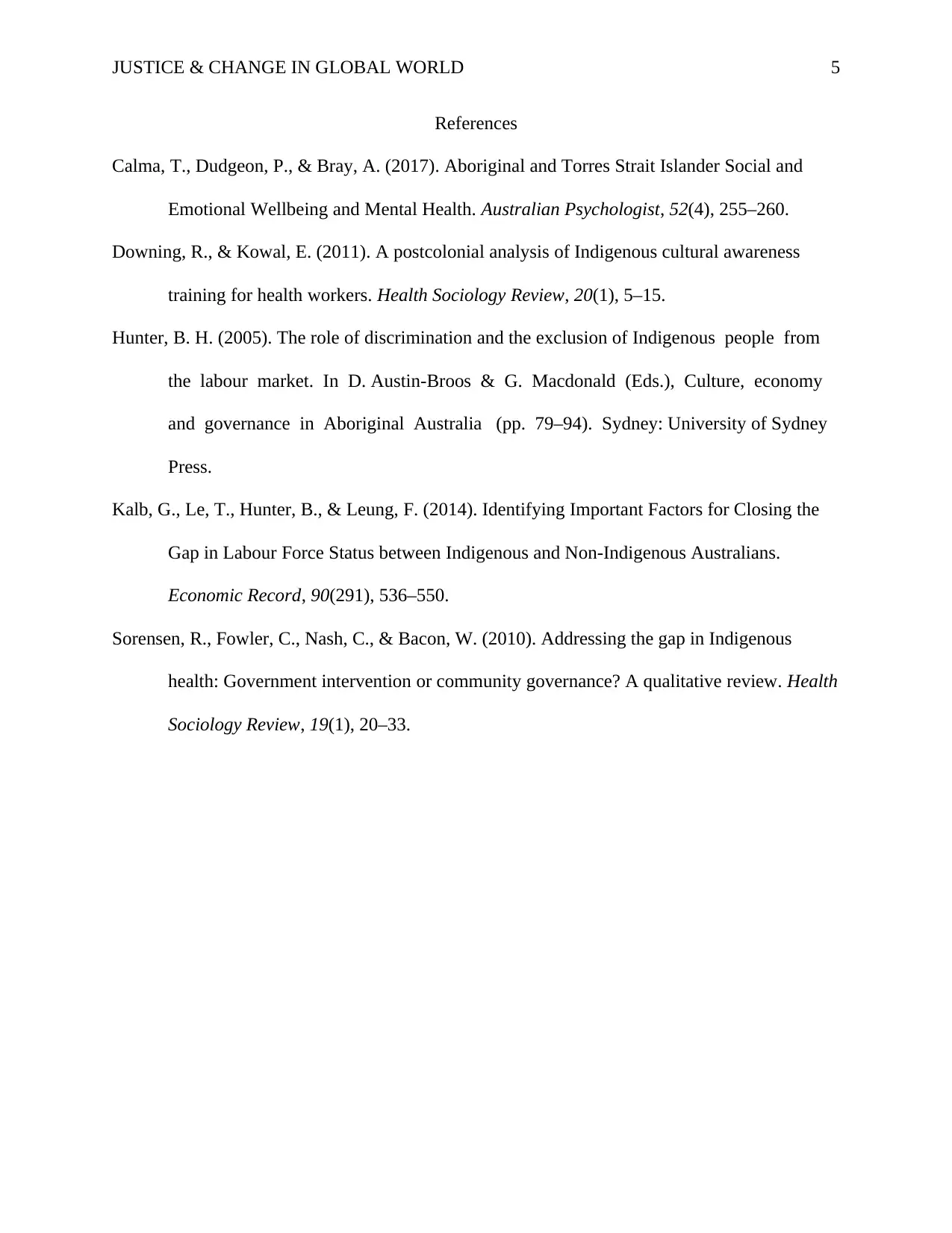Justice and Change in Global Health: Indigenous Health Disparity
VerifiedAdded on 2023/06/04
|5
|1118
|228
Report
AI Summary
This report analyzes the significant health disparities between indigenous and non-indigenous populations globally, focusing on challenges related to chronic diseases, access to primary healthcare, and cultural barriers. It highlights the impact of socioeconomic factors, marginalization, and racism on indigenous communities' health outcomes. The paper examines the challenges faced by healthcare professionals in addressing these issues, emphasizing the need for improved cultural sensitivity, support structures for indigenous health workers, and community engagement. The report proposes solutions such as addressing cultural barriers, combating racism, and involving indigenous communities in healthcare delivery to improve health outcomes and promote health equity. The report also highlights the importance of research and intervention to protect disadvantaged indigenous communities and ensure universal healthcare access.

Running head: JUSTICE & CHANGE IN GLOBAL WORLD 1
Justice and Change in Global World
Name:
Institutional affiliation:
Justice and Change in Global World
Name:
Institutional affiliation:
Paraphrase This Document
Need a fresh take? Get an instant paraphrase of this document with our AI Paraphraser

JUSTICE & CHANGE IN GLOBAL WORLD 2
Justice and Change in Global World
Improving Participation for Indigenous Communities: Health
There is a huge disparity between the non-indigenous and indigenous people’s health and
life expectancy. This has been a major global challenge. Chronic diseases are associated with gap
in life expectancy for various populations around the world. Various researches suggest that
chronic situations management models on self-management have resulted to better health results
in Indigenous people. Additionally, indigenous people always find it challenging to access the
primary health care (Kalb, Le, Hunter & Leung, 2014). Therefore, this paper intends to analyze
the challenges faced by nursing professionals in relation to realizing aspirations of the common
good of the indigenous population in their profession, locally, and globally.
Background Information
Chronic conditions are the casual of numerous disability and death within the local
communities and to the world at large. Such conditions results to a substantial impact on the
quality of life within the various indigenous communities around the world. Chronic condition
affects the indigenous group in a wider scale than non-indigenous. Indigenous people get
affected by chronic conditions at an early stage, which accounts to for the wide gap in death rate
between the non-indigenous and indigenous groups (Sorensen, Fowler, Nash, & Bacon, 2010).
Moreover, the indigenous people have not been able to fully accessing more effective advanced
chronic condition management (CCM) due to exclusion and marginalization they experience
from the mainstream. Moreover, self-management is being involved in the management of
individual’s disease on all aspects of living. However, there is a concern that CCM models of
care must look into the emotional, economical, and social awareness of the indigenous in relation
to sensitivity to the consequences of loss and grief they faced in relation colonization.
Justice and Change in Global World
Improving Participation for Indigenous Communities: Health
There is a huge disparity between the non-indigenous and indigenous people’s health and
life expectancy. This has been a major global challenge. Chronic diseases are associated with gap
in life expectancy for various populations around the world. Various researches suggest that
chronic situations management models on self-management have resulted to better health results
in Indigenous people. Additionally, indigenous people always find it challenging to access the
primary health care (Kalb, Le, Hunter & Leung, 2014). Therefore, this paper intends to analyze
the challenges faced by nursing professionals in relation to realizing aspirations of the common
good of the indigenous population in their profession, locally, and globally.
Background Information
Chronic conditions are the casual of numerous disability and death within the local
communities and to the world at large. Such conditions results to a substantial impact on the
quality of life within the various indigenous communities around the world. Chronic condition
affects the indigenous group in a wider scale than non-indigenous. Indigenous people get
affected by chronic conditions at an early stage, which accounts to for the wide gap in death rate
between the non-indigenous and indigenous groups (Sorensen, Fowler, Nash, & Bacon, 2010).
Moreover, the indigenous people have not been able to fully accessing more effective advanced
chronic condition management (CCM) due to exclusion and marginalization they experience
from the mainstream. Moreover, self-management is being involved in the management of
individual’s disease on all aspects of living. However, there is a concern that CCM models of
care must look into the emotional, economical, and social awareness of the indigenous in relation
to sensitivity to the consequences of loss and grief they faced in relation colonization.

JUSTICE & CHANGE IN GLOBAL WORLD 3
Opposition
It is not right to deny indigenous people the right to access primary health care based on
racism, discrimination, social difference, culture, or language. Heath workers should not found
themselves working round-the-clock without having time to rest; there must be line between life
and work. Lack of clear structures to aid healthcare should be a thing of the past. Indigenous
health workers should not burn out when providing health care.
Position
Access to healthcare and indigenous health workers is vital for indigenous population as
deprived cultural protection in majority health services create barriers and discourage access to
disease information by the patent. Such challenges contribute to poor confidence in self-
management. Problems such as marginalization and racism also have negative impact on health,
and it is evident in the health sector (Downing & Kowal, 2011).
On the other hand, appropriate cultural communication in the context of varied global-
views physiology’s concept and illness can be challenging. Various researches also show that
competing for basic priorities such as housing, employment, and education are the sources for
causing barrier for patient’s self-managing (Sorensen, Fowler, Nash, & Bacon, 2010). Such
competition perpetuates the feeling of disempowerment and fear among the indigenous
population. Consequently, poor socioeconomic conditions are also the main barriers to self-
manage. Social issues such lack of education and poverty are associated with poor health literacy
(Calma, Dudgeon & Bray, 2017). As a result of this, indigenous subgroups get marginalized,
which of prevalence in non-indigenous health facilities.
Solution
Opposition
It is not right to deny indigenous people the right to access primary health care based on
racism, discrimination, social difference, culture, or language. Heath workers should not found
themselves working round-the-clock without having time to rest; there must be line between life
and work. Lack of clear structures to aid healthcare should be a thing of the past. Indigenous
health workers should not burn out when providing health care.
Position
Access to healthcare and indigenous health workers is vital for indigenous population as
deprived cultural protection in majority health services create barriers and discourage access to
disease information by the patent. Such challenges contribute to poor confidence in self-
management. Problems such as marginalization and racism also have negative impact on health,
and it is evident in the health sector (Downing & Kowal, 2011).
On the other hand, appropriate cultural communication in the context of varied global-
views physiology’s concept and illness can be challenging. Various researches also show that
competing for basic priorities such as housing, employment, and education are the sources for
causing barrier for patient’s self-managing (Sorensen, Fowler, Nash, & Bacon, 2010). Such
competition perpetuates the feeling of disempowerment and fear among the indigenous
population. Consequently, poor socioeconomic conditions are also the main barriers to self-
manage. Social issues such lack of education and poverty are associated with poor health literacy
(Calma, Dudgeon & Bray, 2017). As a result of this, indigenous subgroups get marginalized,
which of prevalence in non-indigenous health facilities.
Solution
⊘ This is a preview!⊘
Do you want full access?
Subscribe today to unlock all pages.

Trusted by 1+ million students worldwide

JUSTICE & CHANGE IN GLOBAL WORLD 4
Even though, these are challenges facing health providers, they can be reversed. It
is because various studies show that the burn burnout and attrition of the indigenous health
workers is caused by limited support and exclusion from the decision-making by other staff
within the healthcare (Hunter, 2005). Lack of healthcare nurses and other health professionals
can impact the continuity of care; hence, resulting to inconsistencies and patient get demoralized.
Support structure of the IHW is a major requirement together with the implementation of CCM
programs. Enough staffing is required to reduce the pressure on indigenous health workers so
that they may get time for caring for chronic conditions.
Conclusion
Healthcare is a basic human right, therefore, interventions are required to help and protect
the disadvantaged indigenous. Cultural barriers and racism should not be used to prevent
universal healthcare. Therefore, more work and research is needed when considering the roles of
professional healthcare and nurses in indigenous society. Further, every stakeholder in the
indigenous society should be involved in the running of the schools to help in solving education
barrier. Finally, it is vital to engage the indigenous community when providing healthcare to
make it easier for the healthcare providers to provide care to the entire community.
Even though, these are challenges facing health providers, they can be reversed. It
is because various studies show that the burn burnout and attrition of the indigenous health
workers is caused by limited support and exclusion from the decision-making by other staff
within the healthcare (Hunter, 2005). Lack of healthcare nurses and other health professionals
can impact the continuity of care; hence, resulting to inconsistencies and patient get demoralized.
Support structure of the IHW is a major requirement together with the implementation of CCM
programs. Enough staffing is required to reduce the pressure on indigenous health workers so
that they may get time for caring for chronic conditions.
Conclusion
Healthcare is a basic human right, therefore, interventions are required to help and protect
the disadvantaged indigenous. Cultural barriers and racism should not be used to prevent
universal healthcare. Therefore, more work and research is needed when considering the roles of
professional healthcare and nurses in indigenous society. Further, every stakeholder in the
indigenous society should be involved in the running of the schools to help in solving education
barrier. Finally, it is vital to engage the indigenous community when providing healthcare to
make it easier for the healthcare providers to provide care to the entire community.
Paraphrase This Document
Need a fresh take? Get an instant paraphrase of this document with our AI Paraphraser

JUSTICE & CHANGE IN GLOBAL WORLD 5
References
Calma, T., Dudgeon, P., & Bray, A. (2017). Aboriginal and Torres Strait Islander Social and
Emotional Wellbeing and Mental Health. Australian Psychologist, 52(4), 255–260.
Downing, R., & Kowal, E. (2011). A postcolonial analysis of Indigenous cultural awareness
training for health workers. Health Sociology Review, 20(1), 5–15.
Hunter, B. H. (2005). The role of discrimination and the exclusion of Indigenous people from
the labour market. In D. Austin-Broos & G. Macdonald (Eds.), Culture, economy
and governance in Aboriginal Australia (pp. 79–94). Sydney: University of Sydney
Press.
Kalb, G., Le, T., Hunter, B., & Leung, F. (2014). Identifying Important Factors for Closing the
Gap in Labour Force Status between Indigenous and Non-Indigenous Australians.
Economic Record, 90(291), 536–550.
Sorensen, R., Fowler, C., Nash, C., & Bacon, W. (2010). Addressing the gap in Indigenous
health: Government intervention or community governance? A qualitative review. Health
Sociology Review, 19(1), 20–33.
References
Calma, T., Dudgeon, P., & Bray, A. (2017). Aboriginal and Torres Strait Islander Social and
Emotional Wellbeing and Mental Health. Australian Psychologist, 52(4), 255–260.
Downing, R., & Kowal, E. (2011). A postcolonial analysis of Indigenous cultural awareness
training for health workers. Health Sociology Review, 20(1), 5–15.
Hunter, B. H. (2005). The role of discrimination and the exclusion of Indigenous people from
the labour market. In D. Austin-Broos & G. Macdonald (Eds.), Culture, economy
and governance in Aboriginal Australia (pp. 79–94). Sydney: University of Sydney
Press.
Kalb, G., Le, T., Hunter, B., & Leung, F. (2014). Identifying Important Factors for Closing the
Gap in Labour Force Status between Indigenous and Non-Indigenous Australians.
Economic Record, 90(291), 536–550.
Sorensen, R., Fowler, C., Nash, C., & Bacon, W. (2010). Addressing the gap in Indigenous
health: Government intervention or community governance? A qualitative review. Health
Sociology Review, 19(1), 20–33.
1 out of 5
Related Documents
Your All-in-One AI-Powered Toolkit for Academic Success.
+13062052269
info@desklib.com
Available 24*7 on WhatsApp / Email
![[object Object]](/_next/static/media/star-bottom.7253800d.svg)
Unlock your academic potential
Copyright © 2020–2025 A2Z Services. All Rights Reserved. Developed and managed by ZUCOL.





